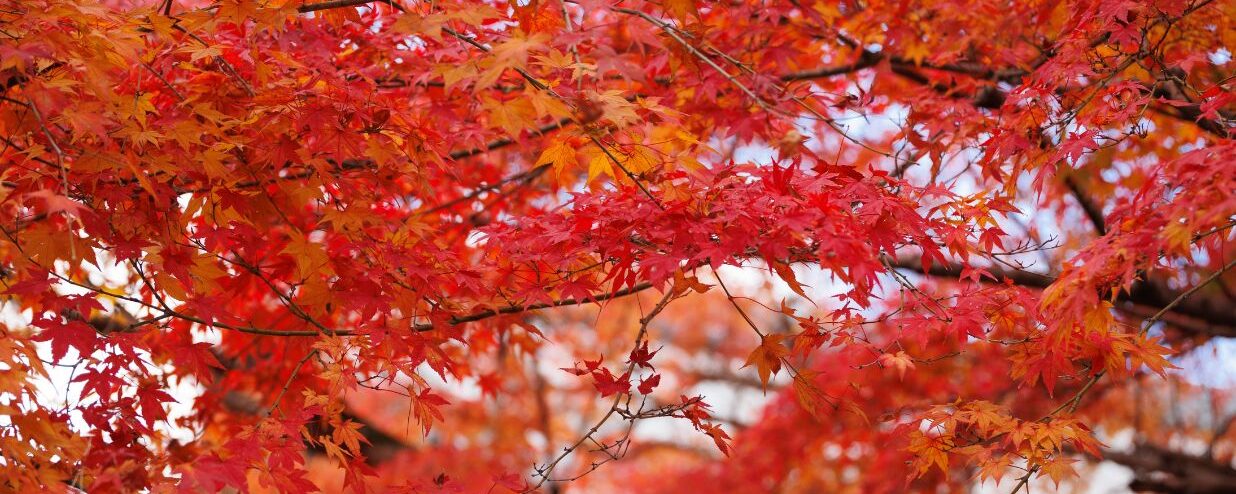As summer humidity fades and fireworks and matsuri festivals come to an end, Tokyo enters one of its most enchanting seasons: autumn.
While spring’s cherry blossoms often steal the limelight, the city’s fall foliage, known as momiji, offers a quieter, equally mesmerizing beauty. From brilliant crimson maples to golden ginkgo trees, the changing leaves transform Tokyo’s parks, gardens, and even bustling streets into breathtaking autumn landscapes. Leaf viewing in the city is particularly unique as it combines urban cityscapes with serene pockets of natural beauty. According to the latest fall foliage forecasts, Tokyo’s leaves typically reach their peak color in late November.
Curious where to experience the best of Tokyo’s autumn colors? From iconic gardens to hidden green pockets, here are the top places to enjoy the city’s spectacular fall leaves.
What to Know Beforehand About Autumn Leaves in Tokyo
Did you know that not all autumn leaves, or momiji, are the same? In fact, fall foliage forecasts in Japan often distinguish between two main types: the red leaves from momiji and kaede trees, which reach their signature vermillion hues toward the end of November, and the bright yellow leaves of ginkgo trees.
In Tokyo, some spots are known for a particular type of autumn foliage. Showa Kinen Park in Tachikawa, for example, is famous for its ginkgo trees, which are among the first to turn. As soon as you enter the park’s Tachikawa Gate, you’re greeted by two boulevards of golden-yellow trees. Another iconic spot is Meiji Jingu Gaien, renowned for its grand avenue of 150 ginkgo trees lining a 300-meter stretch, which transforms into a brilliant golden-yellow tunnel in autumn.
Always check in advance what each of Tokyo’s best autumn leaf viewing spots offers, especially if you’re hunting for a specific shade—or looking for those perfect Instagram-worthy photos!
Another important tip is to keep an eye on closing times. While most of the top momiji spots in Tokyo are public parks, some may close earlier than expected, such as Showa Kinen Park, so plan your visit accordingly.
When Does Autumn Leave Peak in Tokyo?
According to the first fall 2025 forecast from the Japan Meteorological Agency, autumn leaves in Tokyo are expected to peak on 26 November for yellow leaves and 30 November for red leaves, meaning the prime viewing period will be roughly from mid-November to mid-December. Keep in mind that this forecast may be updated in the coming weeks, so be sure to check the Japan Meteorological Agency for the latest information.
Check out our more complete guide on the autumn foliage forecast in other parts of Japan.
Best Spots to View Momiji (Autumn Leaves) in Tokyo
1. Showa Kinen Park
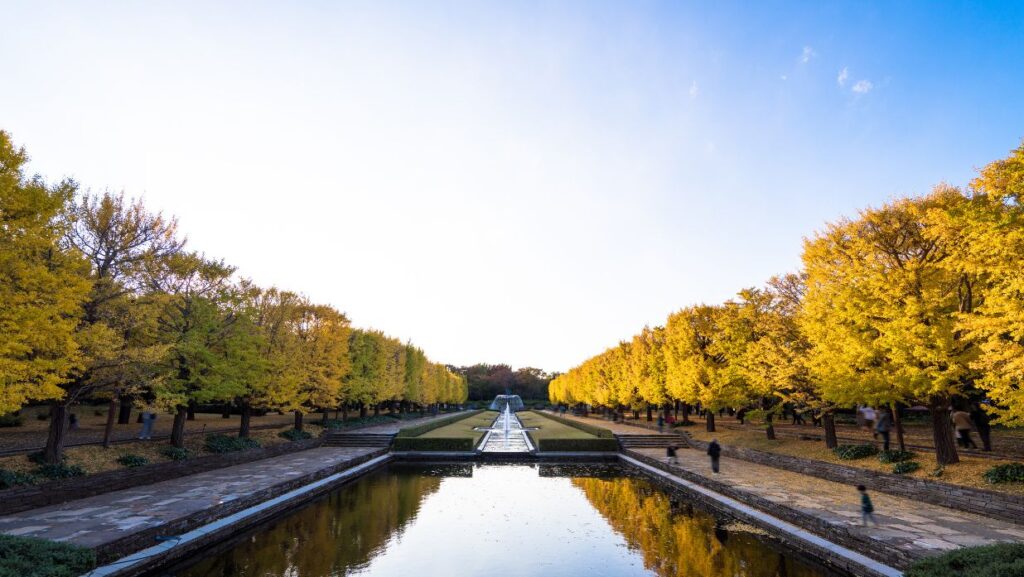
If you ever find yourself on the west side of Tokyo, set aside a day to explore Showa Kinen Park or Showa Memorial Park in Tachikawa.
As one of the best places to view autumn leaves in Tokyo, Showa Kinen Park offers a mix of both maple (momiji) and ginkgo trees. That said, you can head straight for the ginkgo trees. These trees are the first to change color, and as soon as you enter the park’s Tachikawa Gate, you’re greeted by two boulevards of golden-yellow ginkgo trees.
The ginkgo trees are expected to reach their full yellow splendor by mid-November, while the momiji and kaede trees display their signature vermillion shades a bit later, toward the end of November.
During this season, the park extends its hours into the evening, offering special light-ups along Ginkgo Tree Avenue and in the traditional Japanese Garden.
Access: The park’s Nishi-Tachikawa Gate is a 2-minute walk from Nishi-Tachikawa Station.
Fee: ¥450
2. Meiji Jingu Gaien Ginkgo Avenue
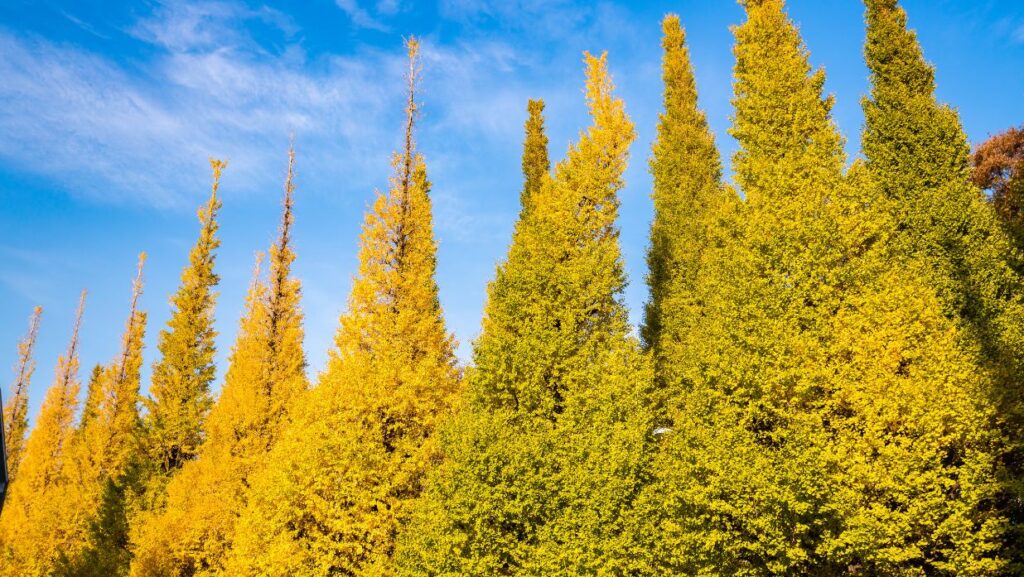
Otherwise, a pretty mundane strip connecting the main street with Meiji Jingu Gaien Garden in Kita-Aoyama, Tokyo, Meiji Jingu Gaien Ginkgo Avenue transforms into an autumnal destination once a year, from late November to early December.
This is because the avenue is an iconic 300-meter path lined with 146 ginkgo trees on both sides. During autumn, the ginkgo leaves turn a fabulous golden hue, attracting crowds eager to photograph the towering trees that form a vibrant yellow tunnel. From mid-November to early December, the area also hosts the annual autumn festival, featuring food stalls offering regional specialties from across Japan.
Access: Meiji Jingu Gaien Ginkgo Avenue is just a 5-minute walk from Aoyama-Itchome Station
Fee: Free
3. Koishikawa Korakuen Garden
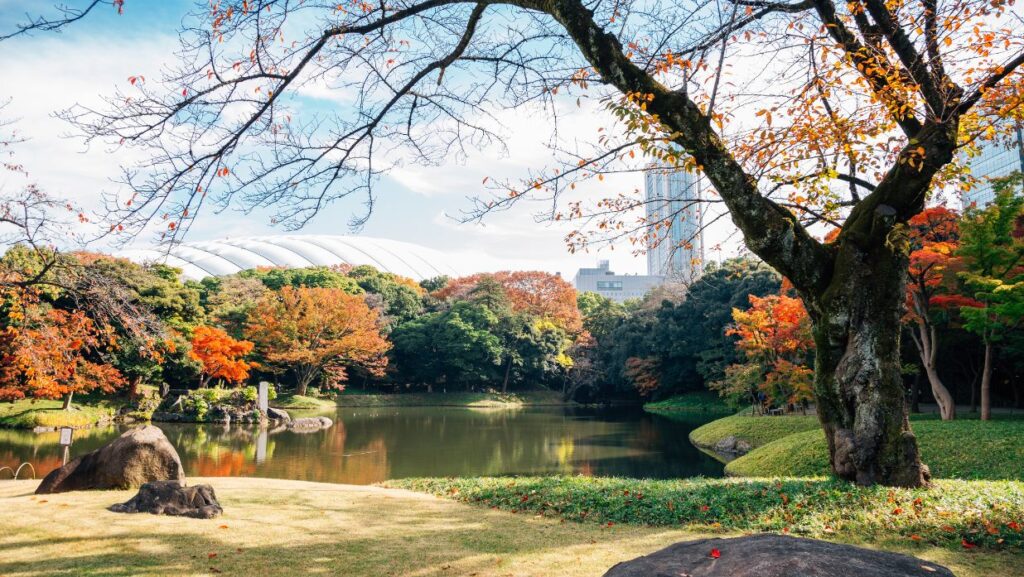
One of Tokyo’s oldest and most stunning Japanese gardens, Koshikawa Korakuen is especially captivating during the fall. The garden, which was built during the early Edo period (1600 – 1868), is anchored with three ponds.
During autumn, dozens of maple trees surrounding the ponds turn vibrant shades of red and orange. There is even a network of walking trails that guides visitors to a small grove of ginkgo trees near the east entrance, which glow in brilliant golden yellow.
The garden was designed to mimic natural landscapes in miniature. Ponds, stones, trees, and man-made hills create a serene environment that, despite being just next to Tokyo Dome, feels miles away from the city.
Access: Koshikawa Korakuen Garden is a 3-minute walk from Suidobashi Station
Fee: ¥300
4. Yoyogi Park
Known locally as Yoyogi Koen, Yoyogi Park is perfect for those who want to enjoy autumn leaves in Tokyo a little more casually than the Instagram-heavy crowds at Meiji Jingu Gaien or Showa Kinen Park. The park is a favorite for picnics, jogging, family outings, and even has a couple of dog parks nearby.
Head into the park to enjoy a wide collection of fiery maples and golden ginkgo trees. You can soak up the crisp autumn air and vibrant foliage while still being just a short walk from the bustling streets of Harajuku and Shibuya. The ginkgo trees near the Harajuku Gate, the zelkova trees in the central area, and the Japanese maples around the fountain pond are among the best spots to admire the fall colors.
Access: Yoyogi Park is a 5-minute walk from Harajuku Station.
Fee: Free
5. Inokashira Park
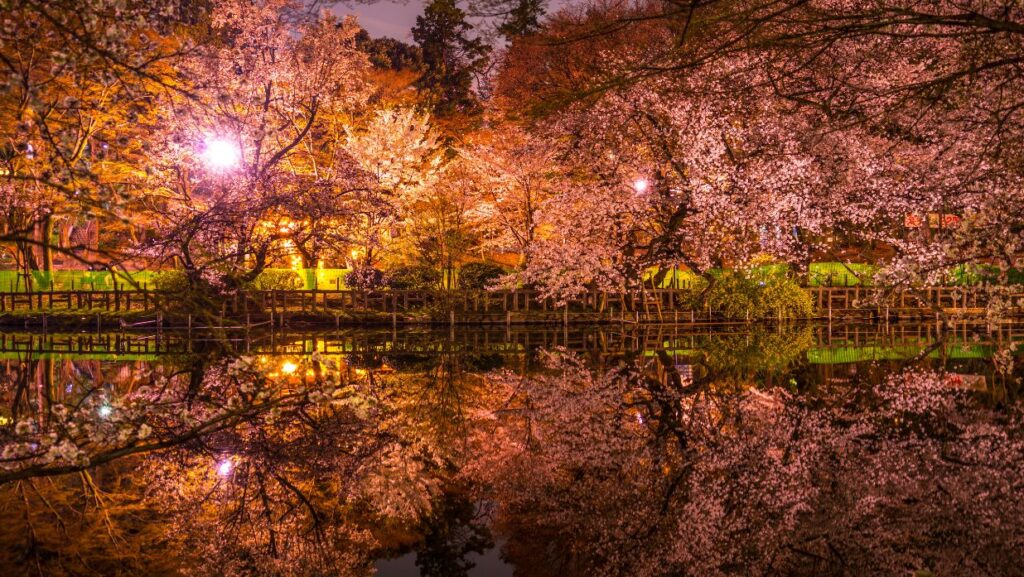
Kichijoji is one of those Tokyo neighborhoods that doesn’t always make the top of travel lists, but it should. Tucked away in the city’s west side, it contains temples, little shops, the Ghibli Museum, and even a zoo.
The real heart of the area is Inokashira Park in Mitaka, with a big, calm lake at its center. In autumn, the park turns into a sea of reds and golds: momiji maples and cherry trees glowing over the water. You can rent a boat and drift past the leaves, or just wander the paths with something warm from one of the food stalls.
Access: Inokashira Park is a 1-minute walk from Inokashira-koen Station
Fee: Free
6. Musashino Park
Tucked away in Koganei along the Nogawa River, Musashino Park is one of Tokyo’s more idyllic escapes. The park has its own nursery where seedlings are grown before being transplanted to other parks and streets across Tokyo.
With more than 5,000 trees, including cherry and maple trees, Musashino Park is often packed with families on picnics and kids playing casual ball games. In autumn, the scenery is especially striking: around 60 Japanese maple trees along the Nogawa River turn brilliant shades of red, joined by a variety of other deciduous trees that light up the park in warm color. It is also one of the rare spots in Tokyo where you can barbecue!
Access: Musashino Park is a 15-minute walk from Shin-Koganei Station
Fee: Free
7. Imperial Palace East Gardens
While the autumn foliage at the Imperial Palace may not be as dramatic as the fiery slopes of Mt. Takao or the golden tunnels of ginkgo trees elsewhere in Tokyo, its beauty lies in meticulous care and refined aesthetics. Every tree and pathway feels carefully groomed, making the palace grounds a uniquely serene place amidst the bustling metropolitan scene.
Among the highlights are the Imperial Palace East Gardens, or Koukyo Higashi Gyoen, which have been open to the public since 1968. Once part of the innermost palace grounds, the gardens showcase not just autumn colors, but carefully designed landscapes that change gracefully with each season. In autumn, the Ninomaru Forest, created under Emperor Showa, becomes a standout spot. Here, visitors can walk among maples, jolcham oaks, and sawtooth oaks.
Another seasonal highlight is Inui Street, a road that cuts across the palace grounds. Usually closed to the public, it opens for a limited time every spring and autumn.
Access: The Tokyo Imperial Palace is a 10-minute walk from Tokyo Station.
Fee: Free (may require prior online reservation)
8. Mt. Takao
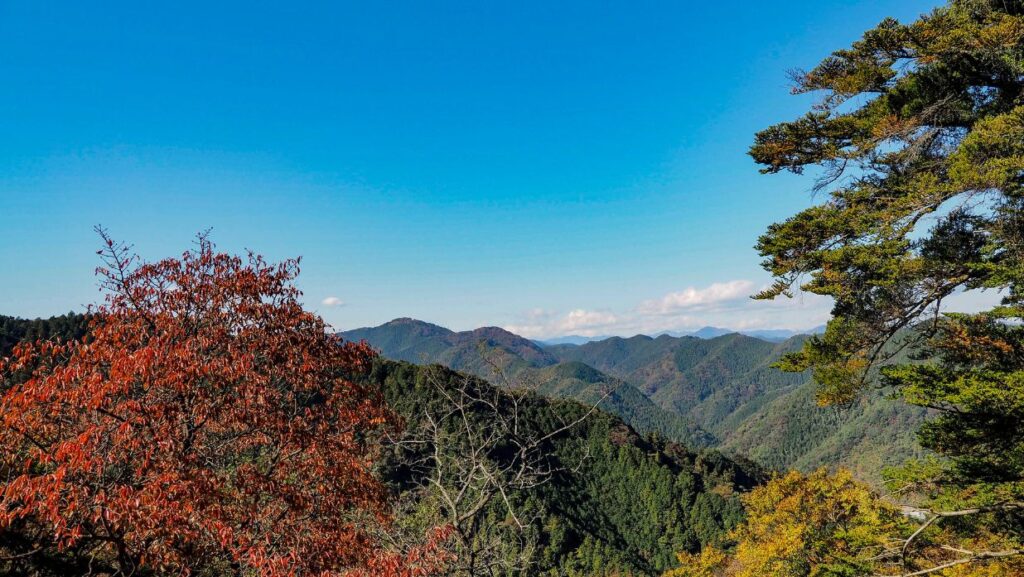
Rising 599 meters, Mt Takao, or Takao-san, in Hachioji is one of the city’s favorite escapes for autumn foliage. It is just an hour from central Tokyo.
In November, the slopes ignite in brilliant shades of red, orange, and yellow, drawing crowds eager to catch the koyo front (autumn leaf change). If you’re not up for the full hike, a cable car and chairlift can carry you halfway up, where trails of varying difficulty continue to the summit. On clear days, the reward at the top is a sweeping panorama that stretches all the way to Mount Fuji. For a perfect foliage view, don’t miss Momiji-dai (Maple Viewing Platform), about ten minutes from the summit.
Autumn also brings the Mount Takao Autumn Leaves Festival, held around the Kiyotake cable car station at the mountain’s base.
Access: Mt. Takao’s cable car station (Kiyotaki Station) is a 5-minute walk from Takaosanguchi Station.
Fee: Free (you need to pay for cable car tickets)
Read More: 10 Best Alternatives for Hiking Besides Mt. Fuji
9. Mt. Mitake
Another great hiking destination in Tokyo is Mount Mitake, located in the Okutama region, the city’s westernmost area. It is located than two hours from central Tokyo. A scenic train and cable car ride brings you up the mountain, where vibrant maple trees and panoramic views greet you at every turn. At the summit sits the historic Musashi-Mitake Shrine. From the upper cable car station, it’s a 20–30 minute walk to the shrine, along trails draped in fall foliage.
The mountain also features the Rock Garden Trail, a peaceful path lined with moss-covered rocks and small waterfalls, and Nagaodaira, an open area perfect for taking in the surrounding autumn scenery. Trails cater to hikers of all levels, making Mount Mitake an accessible spot.
Access: From Mitake Station, it is around a 40-minute walk to get to the cablecar station.
Fee: ¥500
10. Shinjuku Gyoen National Garden
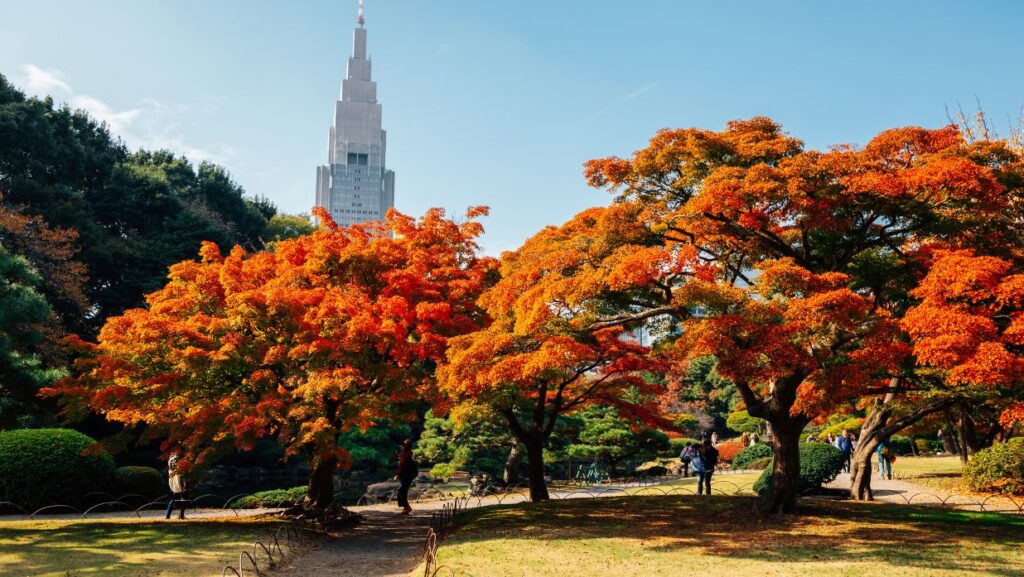
Shinjuku Gyoen National Garden is particularly famous for cherry blossoms in spring, but autumn brings its own spectacular show. Maple and plane trees turn vivid shades of red, orange, and gold, creating one of the city’s most beautiful fall landscapes.
The park combines three distinct garden styles (Japanese traditional, formal French, and English landscape) with sprawling lawns, ponds, and carefully curated plantings. In autumn, visitors can also enjoy the Chrysanthemum Exhibition, an annual event historically associated with the imperial family.
Access: Shinjuku Gyoen National Garden is around a 5-minute walk from Shinjuku-gyoenmae Station
Fee: ¥500
11. Todoroki Valley
Todoroki Valley in Setagaya is a hidden gem for autumn foliage: quiet, natural, and far from the manicured gardens of central Tokyo. Unlike the other parks, Todoroki offers a kilometer-long trail along the Yazawa River where you can enjoy koyo at a leisurely pace.
We recommend exploring Todoroki Fudoson Temple, where golden ginkgo leaves blanket the paths and maple trees wrap the temple in vivid autumn colors. At the southern end of the valley, you can find the Nihon Teien, a small traditional Japanese garden.
Access: From Mitake Station, it is approximately a 40-minute walk to the cable car station.
Fee: Free (you need to pay for cable car tickets)
Access: Todoroki Valley is a 1-minute walk from Todoroki Station
Fee: Free
Conclusion: Enjoy Tokyo’s Autumn, Travel Like a Local, and Learn Japanese
We hope our recommendations on the best places to see autumn leaves in Tokyo! Japan is a beautiful country to visit any time of year, and what better way to experience it fully than by learning a bit of Japanese to immerse yourself in the culture?
This is your sign to join short-term Japanese lessons at Coto Academy courses to learn basic Japanese and start speaking confidently! As Tokyo’s no. 1 Japanese language school, our course focuses on practical Japanese in small, interactive classes of up to 8 students, making learning fun and engaging. We offer intensive Japanese courses as well as part-time options, so whether you want to immerse yourself fully or fit lessons into a busy schedule, there’s something for you.
Why Choose Coto Academy?
- Flexible courses: Join for as little as 1 week and extend as much as you like.
- Small classes: Taught by professional, experienced teachers.
- Convenient locations: Study in the heart of Tokyo, in Shibuya, with three other campuses available.
- Structured learning: 18 course levels with accurate level checks, ensuring a clear progression path.
Experience Japan like a local this autumn! Learn the language, explore the culture, and make your trip unforgettable. Ready to get started? Fill out the form below for a free level check and consultation!
FAQ
When is the best time to see autumn leaves in Tokyo?
The peak season is usually late November to early December, when the leaves turn vibrant red and gold.
Where are the top spots to view autumn leaves in Tokyo?
Popular spots include Shinjuku Gyoen, Rikugien Garden, Meiji Jingu Gaien, and Koishikawa Korakuen.
Are there any free places to enjoy autumn leaves in Tokyo?
Yes, public parks like Yoyogi Park and Ueno Park offer beautiful autumn foliage for free.
Can I take photos during autumn leaf season in Tokyo?
Absolutely! Many parks and gardens provide scenic spots perfect for photography.
Do I need to book tickets to see autumn leaves in Tokyo?
Some gardens like Rikugien or Koishikawa Korakuen may require an entrance fee, but most parks are free to enter.
Exploring Japan during the coziest season of the year? You might want to read:
